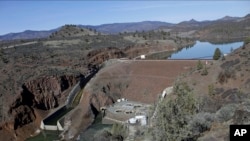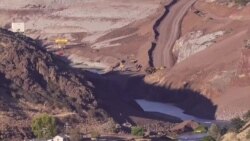ຢູ່ທາງຝັ່ງຝາກຕາເວັນຕົກຂອງສະຫະລັດ, ບັນດານັກອະນຸລັກ ໃນໂຄງການຖອນເຂື່ອນໄຟຟ້າອອກທີ່ໃຫຍ່ທີ່ສຸດໃນໂລກ ກຳລັງສະເຫຼີມ ສະຫຼອງຄວາມສຳເລັດເບື້ອງຕົ້ນ ແລະ ປະເຊີນກັບອຸປະສັກໃນໄລຍະສັ້ນ. ແມັທ ດິບເບີລ (Matt Dibble) ນັກຂ່າວ VOA ລາຍງານຈາກ ແມ່ນ້ຳ ຄລາເມັດ, ຢູ່ບໍລິເວນຊາຍແດນລະຫວ່າງ ລັດຄາລິຟໍເນຍ ແລະ ລັດອໍເຣກອນ. ເຊີນທ່ານຟັງລາຍລະອຽດໃນອັນດັບຕໍ່ໄປ.
ເຂື່ອນໄຟຟ້າພະລັງງານນ້ຳທີ່ເກົ່າແກ່ແຫ່ງສຸດທ້າຍຈາກທັງໝົດສີ່ເຂື່ອນ ຖືກຖອນອອກຈາກແມ່ນ້ຳຄລາແມັດໃນປີນີ້, ແມ່ນ້ຳສາຍນີ້ຍາວປະມານ 400 ກິໂລແມັດຈາກພາກໃຕ້ຂອງລັດອໍເຣກອນ ໄປຈົນຮອດຊາຍຝັ່ງລັດຄາລິຟໍເນຍ. ເປັນໂຄງການຖອນເຂື່ອນທີ່ໃຫຍ່ທີ່ສຸດທີ່ເຄີຍດຳເນີນການມາ, ໂດຍມີເປົ້າໝາຍ ເພື່ອຟື້ນຟູສຸຂະພາບຂອງແມ່ນ້ຳ ແລະ ນຳເອົາປາທີ່ເຄີຍອາໄສຢູ່ນີ້ແລ້ວ ອົບພະຍົບອອກໄປກັບຄືນມາ.
ຄວາມພະຍາຍາມຄັ້ງໃຫຍ່ນີ້ເບິ່ງຄືຈະໄດ້ຮັບຜົນທີ່ດີ. ພຽງແຕ່ສອງເດືອນຫຼັງ ຈາກການຖອນເຂື່ອນສຸດທ້າຍ ທ້າຍເດືອນສິງຫາ ໄດ້ມີການພົບເຫັນປາແຊລມອນ ກຳລັງວາງໄຂ່ໃນສາຂາຂອງແມ່ນ້ຳທີ່ຖືກ ປິດກັ້ນໄວ້ຫຼາຍກວ່າ 100 ປີ.
ແຕ່ການແກ້ໄຂການແຊກແຊງຂອງຄົນທີ່ມີມາໜຶ່ງສັດຕະວັດກໍ່ມາພ້ອມກັບຄວາມສ່ຽງດ້ານສິ່ງແວດລ້ອມຂອງມັນເອງ.
ທ່ານ ເດບ ຄອຟແມນ, ຈາກອົງການແກ້ໄຂບັນຫາຊັບພະຍາກອນ ສິ່ງແວດລ້ອມກ່າວວ່າ່
"ເຈັບໃນໄລຍະສັ້ນ, ໄດ້ໃນໄລຍະຍາວ."
ທ່ານ ເດບ ຄອຟແມນ (Dave Coffman) ເປັນຜູ້ຈັດການໂຄງການ ເຂດລຸ່ມແມ່ນ້ຳ ຄລາແມັດ ຂອງອົງການແກ້ໄຂບັນຫາຊັບພະຍາກອນສິ່ງແວດລ້ອມ (Resource Environmental Solutions). ລາວໄດ້ກະກຽມສຳລັບຊ່ວງ ເວລານີ້ມາຫຼາຍກວ່າ 5 ປີ.
ທ່ານ ເດບ ຄອຟແມນ, ການແກ້ໄຂບັນຫາສິ່ງແວດລ້ອມຊັບພະຍາກອນກ່າວວ່າ
"ໃນທີ່ສຸດ, ການປິ່ນປົວແມ່ນ້ຳ ແລະ ໂອກາດເພື່ອການພັດທະນາໄລຍະຍາວ ແມ່ນມີນ້ຳໜັກຫຼາຍກວ່າຜົນກະທົບ."
ການລະບາຍນ້ຳອອກຈາກອ່າງເກັບນ້ຳຢູ່ຫຼັງເຂື່ອນ ໄດ້ເຮັດໃຫ້ຕະກອນສະສົມ ຫຼາຍໂຕນໄຫຼອອກມາ. ນ້ຳຂີ້ຕົ້ມທີ່ຂາດອົກຊີເຈັນໄດ້ເຮັດໃຫ້ປາຈຳນວນນຶ່ງ ຕາຍ.
ເມື່ອລະບາຍນ້ຳອອກແລ້ວ, ກໍເຫຼືອຂີ້ຕົ້ມໜາເກືອບ 900 ເຮັກຕາ, ເຊິ່ງເຮັດໃຫ້ ສັດບາງຊະນິດທີ່ຕິດຢູ່ນັ້ນກຳລັງຊອກຫາແຫຼ່ງນ້ຳຢູ່.
ຕອນນີ້ພື້ນອ່າງເກັບນ້ຳໄດ້ແຫ້ງແລ້ວ ແລະ ກາຍເປັນພື້ນທີ່ອັນຕະລາຍທີ່ທ້າ ທາຍຄວາມພະຍາຍາມໃນການປູກພືດຄືນໃໝ່.
ທ່ານ ເດບ ຄອຟແມນ, ການແກ້ໄຂບັນຫາສິ່ງແວດລ້ອມຊັບພະຍາກອນກ່າວວ່າ
"ພວກເຮົາບໍ່ໄດ້ປູກພືດຢູ່ໃນດິນ. ເຮົາກຳລັງປູກໃນພືດໃນໄຄນ້ຳທີ່ຕາຍໄປແລ້ວ ເຊິ່ງລວມກັນເປັນຂີ້ຕົ້ມຢູ່ລຸ່ມອ່າງເກັບນ້ຳ, ເຊິ່ງຕັ້ງແຕ່ມັນແຫ້ງແລ້ວ, ມັນກໍແຂງຄືກັບຊີມັງ."
ໃນຊ່ວງຫ້າປີທີ່ຜ່ານມາ, ທີມງານສ່ວນໃຫຍ່ທີ່ເປັນສະມາຊິກຊົນເຜົ່າ ຢູຣອກ ໄດ້ຮວບຮວມເອົາເມັດພືດຈາກພືດ ແລະ ຕົ້ນໄມ້ພື້ນເມືອງ.
ການປູກພືດພື້ນເມືອງໄດ້ຊ່ວຍປ້ອງກັນບໍ່ໃຫ້ສິ່ງມີຊີວິດຕ່າງຖິ່ນເຂົ້າມາຮຸກຮານ ແລະ ຈຳກັດບໍ່ພຽງແຕ່ພັນພືດເທົ່ານັ້ນ, ແຕ່ຍັງລວມຮອດພັນສັດທີ່ສາມາດ ອາໄສຢູ່ບ່ອນນີ້ອີກດ້ວຍ.
ໃນຕົ້ນລະດູໃບໄມ້ປົ່ງທີ່ຜ່ານມາ, ເມັດພັນພືດ ໄດ້ຖືກຖິ້ມລົງມາໂດຍເຮືອບິນ ເຮລິຄັອບເຕີ ແລະ ດ້ວຍມື, ເພື່ອໃຊ້ປະໂຫຍດຈາກຝົນຄັ້ງສຸດທ້າຍ ກ່ອນຈະພົບ ກັບຄວາມຮ້ອນໃນລະດູຮ້ອນ.
ທ່ານ ຈອຊ ເຊໂນເວດ (Josh Chenoweth), ນັກນິເວດວິທະຍາສາດ ຊົນເຜົ່າຢູຣອກກ່າວວ່າ
"ມັນແມ່ນປະມານ 65,000 ເກືອບ 66,000 ປອນຂອງເມັດພັນພືດ. 'ປີທຳອິດ' ແມ່ນດີຫຼາຍ. ການຫວ່ານດ້ວຍມືປະສົບຜົນສຳເລັດຫຼາຍ. ແລະ ເມື່ອເຈົ້າຍ່າງ ອອກໄປໃນພູມສັນຖານປະເທດນັ້ນ, ມັນເຕັມໄປດ້ວຍຊີວິດ. ເຜີ້ງ, ແມງໄມ້ ປະສົມເກສອນທຸກຊະນິດ, ນົກ, ສັດລ້ຽງລູກດ້ວຍນົມ."
ແຕ່ບໍ່ແມ່ນສິ່ງມີຊີວິດທຸກຊະນິດທີ່ໄດ້ຮັບການຕ້ອນຮັບ. ມ້າປ່າຍ່າງໄປມາ ແລະ ກິນພືດຢູ່ບ່ອນນີ້ແບບອິດສະຫຼະ. ຝູງມ້າເຊິ່ງຖືກຮວບຮວມໂດຍເຈົ້າຂອງຟາມລ້ຽງສັດໃນທ້ອງຖິ່ນເພື່ອສະກັດກັ້ນ ໄຟໄໝ້ປ່າ, ຕອນນີ້ກຳລັງຄຸກຄາມຄວາມພະຍາຍາມໃນການປູກພືດຄືນໃໝ່.
ທ່ານ ເດບ ຄອຟແມນ, ການແກ້ໄຂບັນຫາສິ່ງແວດລ້ອມຊັບພະຍາກອນກ່າວວ່າ
"ຈຳນວນປະຊາກອນມ້າປ່າໃນພູມສັນຖານນີ້ໄດ້ເພີ່ມຂຶ້ນຈາກຈຳນວນບໍ່ເທົ່າໃດ ເປັນຫຼາຍກວ່າ 200 ໂຕໃນຕອນນີ້."
ທ່ານ ແດໜ້ຽວ ດີຢູລິໂອ, ການແກ້ໄຂບັນຫາສິ່ງແວດລ້ອມຊັບພະຍາກອນກ່າວວ່າ
"ເຈົ້າເຫັນໄດ້ວ່າບ່ອນນີ້ເຮົາມີຄວາມເສຍຫາຍຈາກມ້າບາງສ່ວນ. ຮອຍຕີນ/ ຮອຍເລັບມ້າທີ່ເຂົ້າມາບ່ອນນີ້ ແລະ ຈີກທຸກຢ່າງ. ພວກມັນຍັງເປັນພາຫະນະ ນຳເອົາສາຍພັນຮຸກຮານອື່ນໆເຂົ້າມາອີກດ້ວຍ."
ທີມງານກຳລັງຕິດຕັ້ງຮົ້ວເພີ່ມອີກ 15 ກິໂລແມັດເພື່ອກັ້ນມ້າ ແລະ ກຳຈັດຫຍ້າ ດ້ວຍມື ເຊິ່ງເປັນສ່ວນໜຶ່ງຂອງຄວາມພະຍາຍາມໃນການຟື້ນຟູທີ່ຄາດການວ່າ ຈະດຳເນີນການຕໍ່ໄປຢູ່ບ່ອນນີ້ຢ່າງໜ້ອຍ 5 ປີ.
ອ່ານລາຍງານໃນພາສາອັງກິດ
On the U.S. West Coast, conservationists for the world's largest dam-removal project are both celebrating initial successes and encountering short-term obstacles. VOA's Matt Dibble has our story from the Klamath River on the border between California and Oregon.
The last of four aging hydroelectric dams was removed this year from the Klamath River, which stretches about 400 kilometers from Southern Oregon to the California coast. It is the largest dam removal project ever undertaken, with a goal of restoring the river's health and bringing back the migrating fish that once thrived here.
The massive effort appears to be paying off. Just two months after the final dam was removed, [[end of August]] salmon were spotted,
spawning in a tributary of the river that has been out of reach for over a hundred years.
But undoing a century-old human intervention comes with its own environmental risks
((Dave Coffman, Resource Environmental Solutions))
"Short term pain, long term gain."
Dave Coffman is the Lower Klamath Project program manager for Resource Environmental Solutions. He has been preparing for this moment for more than five years.
((Dave Coffman, Resource Environmental Solutions))
"Ultimately, the healing of the river and its long-term potential for improvement outweighed the short-term impacts."
Draining the reservoirs behind the dams released tons of accumulated sediment. The muddy water lacked oxygen, killing some fish.
Once drained, nearly 900 hectares of thick muck remained, trapping some animals that were searching for water.
Now dried, the reservoir floors are treacherous terrains that challenge re-vegetation efforts.
((Dave Coffman, Resource Environmental Solutions))
"We're not planting in soil. We're planting in dead algae matter that had really formed this muck of a reservoir bottom that since it has dried, has gotten as hard as concrete."
Over the past five years, teams of mostly Yurok tribal members have been gathering seeds
from indigenous plants and trees.
Establishing native plants prevents invasive species from taking over ((End Courtesy)) and severely limiting not only the plant species but also the animal species that can live here.
Beginning last spring, seeds were dropped by ((Courtesy Yurok Tribe)) helicopter, and by hand,
to take advantage of the last rains before the summer heat. ((end courtesy))
((Josh Chenoweth, Yurok Tribe Ecologist))
"It was about 65,000, almost 66,000 pounds, of seed. ((Courtesy Yurok Tribe))
'Year One' was fantastic. The hand sowing was wildly successful. And when you walked out into that landscape it was teeming with life. Bees, all kinds of pollinators, birds, mammals." ((end courtesy))
But not all creatures are welcome. Wild horses roam freely and graze on vegetation here. The herd, which was assembled by a local rancher to suppress wildfires, now threatens the re-vegetation effort.
((Dave Coffman, Resource Environmental Solutions))
"The population of feral horses on the landscape has increased from a handful to over probably 200 right now."
((Daniel DiIulio, Resource Environmental Solutions))
"You can see here we do have some horse damage. Some hoof damage from the horses just coming in here and tearing things up. They're also a vector for introducing invasive species."
The team is installing another 15 kilometers of fencing to keep out the horses and is removing weeds by hand as part of restoration efforts that are expected to continue here for at least another five years.







ຟໍຣັມສະແດງຄວາມຄິດເຫັນ